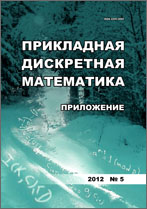|
Mathematical Methods of Cryptography
Elaboration of selfish-mine strategy
A. V. Cheremushkin
Academy of Cryptography of Russian Federation
Abstract:
As it was shown by Ittay Eyal and Emin Gün Sirer, the Bitcoin mining protocol is not incentive-compatible, because there exists an attack in which colluding miners obtain a revenue larger than their fair share. We describe an elaboration of Selfish-Mine Strategy and present an extended model of selfish mining based on independency hypothesis: both groups are made their work independently from each other. We describe a new state machine modelling selfish pool strategy. Let the selfish pool has mining power of p, 0<p<1/2, and the others of (1−p). We also consider the situation in which the others mine a block on the previously private branch (frequency γ(1−p)), and the others mine a block on the public branch (frequency (1−γ)(1−p)). Main result is an elaboration of an interval, in which selfish miners will earn more than their relative mining power: 1) for a given p, a pool of size p obtains a revenue larger than its relative size for p in the following range: 0<p⩽0.429 (the left bound coinsides with γ=1, and the right bound coinsides with γ=0); 2) for a given p, a pool of size p obtains a revenue larger than a revenue of other group in the following range: 0.358⩽p⩽0.449.
Keywords:
blockchain, mining, Markov model, state machine.
Citation:
A. V. Cheremushkin, “Elaboration of selfish-mine strategy”, Prikl. Diskr. Mat. Suppl., 2020, no. 13, 71–77
Linking options:
https://www.mathnet.ru/eng/pdma502 https://www.mathnet.ru/eng/pdma/y2020/i13/p71
|

| Statistics & downloads: |
| Abstract page: | 145 | | Full-text PDF : | 52 | | References: | 23 |
|




 Contact us:
Contact us: Terms of Use
Terms of Use
 Registration to the website
Registration to the website Logotypes
Logotypes









 Citation in format
Citation in format 